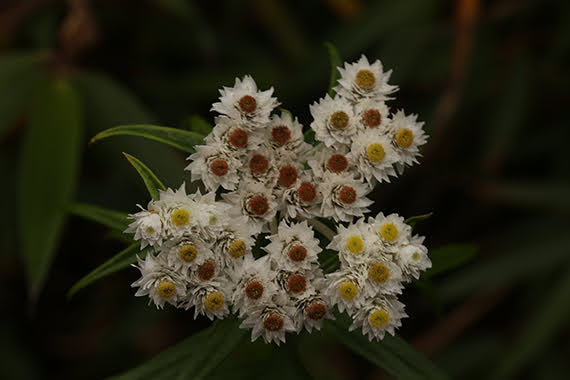Anaphalis margaritacea (L.) Benth. & Hook.f., Gen. Pl. [Bentham & Hooker f.] 2(1): 303 (1873).
Anaphalis margaritacea (L.) Benth. & Hook.f.; Photos Hoang Thanh Son
Vietnamese name:
Bạch nhung bờ, Bạch nhung quế, cây rỉ sắt, Sơn thu, Rau khúc dại
Chinese name:
珠光香青 zhu guang xiang qing
English name:
Latin name:
Anaphalis margaritacea (L.) Benth. & Hook.f.
Synonym name:
Anaphalis angustifolia Rydb.
Anaphalis cinnamomea (DC.) C.B.Clarke
Anaphalis cinnamomea var. cinnamomea
Anaphalis japonica Maxim.
Anaphalis lanata (A.Nelson) Rydb.
Anaphalis margaritacea var. angustior (Miq.) Nakai
Anaphalis margaritacea var. intercedens H.Hara
Anaphalis margaritacea f. margaritacea
Anaphalis margaritacea var. occidentalis Greene
Anaphalis margaritacea var. revoluta Suksd.
Anaphalis margaritacea var. subalpina (A.Gray) A.Gray
Anaphalis margaritaceae subsp. yedoensis (Franch. & Sav.) Kitam.
Anaphalis occidentalis (Greene) A.Heller
Anaphalis sierrae A.Heller
Anaphalis subalpina (A.Gray) Rydb.
Anaphalis timmua D.Don
Anaphalis timmua (Buch.-Ham. ex D.Don) Hand.-Mazz.
Anaphalis yedoensis Maxim.
Antennaria cinnamomea DC.
Antennaria cinnamomea var. cinnamomea
Antennaria margaritacea (L.) R.Br. ex DC.
Antennaria margaritacea (L.) Sweet
Antennaria margaritacea var. subalpina A.Gray
Antennaria plantaginea Sweet
Antennaria timmua Buch.-Ham. ex D.Don
Chamaezelum margaritaceum Link
Gnaphalium americanum Greene
Gnaphalium boreale Salisb.
Gnaphalium hypophaeum Spreng. ex DC.
Gnaphalium margaritaceum L.
Gnaphalium margaritaceum var. margaritaceum
Gnaphalium timmua Buch.-Ham. ex Spreng.
Gnaphalium wightianum Thwaites
Helichrysum margaritaceum (L.) Moench
Family:
Asteraceae
Description:
Herbs, perennial. Rhizome repent, woody, with short brown squamate runners. Stems solitary or a few caespitose, erect or ascending, 30-60(-100) cm, usually thickish, unbranched, rarely branching on broken or normal stems, ash-gray cottony tomentose, base woody. Lower leaves withered by anthesis, apex obtuse; middle leaves expanding, linear or linear-lanceolate, 5-10 cm × 3-12 mm, rarely wider, base attenuate or sharply narrowed, somewhat amplexicaul, margin flat, apex acuminate with small tip; upper leaves gradually smaller with long tip; all leaves slightly leathery, abaxially densely ash-gray to reddish brown lanuginous, adaxially arachnoid or later glabrous, 1-veined, or 3- or 5-veined. Capitula numerous, arranged in compound corymbiform (or corymbiform) synflorescences; peduncle 4-17 mm. Involucre broadly campanulate or semispherical, 5-8 × 8-13 mm; phyllaries 5-7-seriate, somewhat expanding, upper parts white; outer phyllaries up to 1/3 of involucre, ovate, cottony tomentose; middle ones ovate to oblong, ca. 5 × 2.5 mm, up to 3 mm wide in male plants, apex rounded or acuminate; innermost ones linear-lanceolate, ca. 0.5 mm wide, with a claw up to 3/4 of full length. Receptacle alveolate. Predominantly female capitula with many florets, with 3-20 central male florets and many rows of marginal female florets. Predominantly male capitula with many florets, with all central male florets or few rows of marginal female florets. Corolla 3-5 mm. Pappus slightly exserted from corolla, filiform in female florets, incrassate at tip of apex, serrulate in male florets. Achene oblong, ca. 0.7 mm, with glandular dots. 2n = 28*, 42, 56*
Flower and Fruit season:
July-November.
Distribution:
This species is distributed in China, Bhutan, India, Japan, Korea, Myanmar, Nepal, Russia (Far East), N Thailand, Vietnam; North America; widely introduced in Europe.
Ecological:
Conifer and Betula forests, dry soils, subalpine or low mountain grasslands or shrublands, rocky valleys and roadsides, slopes, banks; at an elevation of 300-3500 m. In VietNam, found in Lào Cai (Sa Pa), Lâm Đồng (Đà Lạt, Lạc Dương), Kon Tum (Đắc Lây).
Use:
Treatment of blood vomiting, toothache, limb pain, swelling of the breast (using the whole tree)
Reference:
- theplantlist.org
- efloras.org
- ipni.org







0 Comment:
Post a Comment